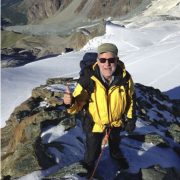From where I stand, the rolling foothills of Northern Italy spread out below me to the south. On my left lie the distinctive peaks of the Dolomite Alps. On my right I can see the massive expanse of Mont Blanc, at 15,781 feet the highest mountain in Europe. I am standing at the summit of the Matterhorn. Knock another item off the bucket list.
I have been trying to climb this mountain for 45 years. During my early attempts I possessed the physical conditioning, but not the money to acquire the necessary equipment needed to get to the top. An ice axe, crampons, helmet, and ropes don?t come cheap to a 16 year old. In later years, vile weather frustrated my every attempt. Now the forecast was perfect, and the sun, the moon, and the stars aligned.
The Matterhorn has long been the premier climbing challenge on the continent. My doctor in Zermatt heads up many rescues and tells me that a dozen people a year die trying. The year 1999 was especially bad, claiming 39 lives. Still, if death isn?t on the table, it?s not worth doing.
I spent a restless night sleeping under a heavy wool blanket in a shared bunk with a dozen other climbers at the 10,695 foot Hornli Hut. Get a group of guys like this together, and there is always one who snores.
At 3:00 AM we bolted out of bed to eat a hardy breakfast of eggs, cold cuts, and lots of strong coffee before launching an assault on the mountain. We then quietly filled canteens and donned climbing harnesses and backpacks. The night sky was crystal clear, an ocean of stars shimmering upon us, with the occasional shooting star giving its blessing.
I had spent the past week acclimatizing myself to the high altitude, completing practice climbs to the top of increasingly difficult surrounding peaks. I was joined by my Swiss guide, Christian, of the Zermatt Alpine Center. In his mid forties, chocolate tanned, with thighs like tree stumps, he had already climbed the Matterhorn an impressive 77 times.
We took off at a rapid pace, passing most of the early starters. Zermatt guides are notorious for speed climbing, the theory being that the quicker they wore out their clients, the sooner they could go home. I realized there was something far more responsible going on. Christian had to gain the confidence that I had enough energy reserves left for the descent, when 90% of all fatalities occur. At 11,800 feet he said ?Good,? and we roped up.
It was about this time that I started to wonder if I should really be here. Most of the climbers we were passing were in their twenties and a few in their thirties, young enough to be my grandchildren. After all, I?m the silver haired gentleman people give their seat up to when riding the San Francisco BART. At 12,200 feet Christian ordered, ?Now we put on our crampons.?
From there on we silently pushed our way upward in the darkness, headlamps illuminating the way, methodically positioning our feet to make the leap to the next boulder above. The mountain has been climbed for 148 years, and many of the surfaces have been polished smooth by boots to the point of becoming dangerously slippery. Much of the slope is frustratingly unstable. Half the rocks you reach for are loose. Stones sent flying by climbers above are a major risk, which is why we wear helmets.
By 5:00 AM we were at 12,700 feet and the sun started to rise. I took out my camera to take a picture, but fumbling with my climbing gloves, I dropped it. It smashed into a dozen pieces and then skittered down into the great Matterhorn crevasse below.
I still had my iPhone 5s to take pictures. But its touch screen required me to take my glove off. With the temperature at 10 degrees below freezing, photos were not worth risking fingers to frostbite. So you?ll just have to read about it.
During the first half of the 19th century, the Matterhorn was the Holy Grail among climbers, and was considered impossible to conquer. Englishman, Edward Whymper, finally led a seven-man team to the top in 1865. He pioneered the same Hornli Ridge route that I was ascending today. But on the way down a rope broke and four perished. One body was never found. Today, you can see the rope in a Zermatt museum, a crude manila affair, along with the clothes from another dead climber found months later.
Some 5,000 now attempt the climb every year, and about 500 make it to the summit. Ulrich Inderbinen made the top over 370 times, and last climbed it when he was 90. I was able to shake his hand at a picture signing in Zermatt a couple of years before he died from old age at 103 (click here for his obituary).
At 13,000 feet we approached the Mosley Slab, so named for an American who fell to his death here in 1879. Beyond beckoned the Solvay Hut, a tiny, precariously sited refuge from weather that suddenly turns bad. Taking a break I found, amazingly, that I still had cell phone reception. Should I send out a Trade Alert from 13,133 feet?
That was where I encountered my first zombie, a climber who grievously underestimated the mountain and had used up every ounce of energy to get this far. His guide was coaxing, shouting, and cajoling him to climb down one rock at a time.
Looking at his dead eyes, you know it was going to be a tough and dangerous descent. I later heard that the poor fellow, Japanese, fell and broke his leg and had to be helicoptered off. There were many more zombies to come.
Above Solvay, we encountered the ?fixed ropes,? which are actually steel cables bolted to the face to help traverse the steepest and most dangerous passages. Lose your grip here, and its 3,000 feet straight down.
This is where we ran into the traffic jam, with simultaneous ascending and descending climbers competing for the same handholds. One dummy actually abseiled down on top of me, nearly knocking me off of my grip. Here, falling climbers are a major danger.
At 300 feet below the summit I passed Sophie?s Ridge, so named for a young Italian woman who was turned back in the 1880?s because high winds were blowing up her Victorian ankle length dress. Now, altitude sickness was taking its toll, with many puking climbers turning back, the disappointment showing on their faces. Luckily, I felt fine.
Not far from there was the location of the original 1865 accident. We approached the small bronze statue of Saint Bernard, the patron saint of mountain climbers. Bolted to the side of the peak, it was covered with ropes, as many teams tie on to it to rappel down.
Then we were on top. The weather was glorious. The summit was graced with a wrought iron cross that one finds atop many Alpine peaks. There was an impatient line of climbers waiting their turn to tag the summit, take some quick pictures, and then start their way down. The feeling of accomplishment was immense.
We carefully picked our way down, rappelling down the steepest faces. By now the sun was well up, the ice was melting, freeing up infinitely more loose rubble. One boulder the size of a small car crashed down 50 feet away, making a thunderous roar. ?Yikes,? I thought, ?we better get out of here.?
At 13,000 feet, we encountered a team with one climber absolutely paralyzed with fear and refusing to budge. After some discussion, I agreed to let her rope up with us and escort her down to the Hornli hut. The other guide was Christian?s friend, and that would enable him to continue upward with his other clients. Our expedition turned into a mountain rescue.
Once Christian tied her in I had second thoughts about being so charitable. If she fell, she could take me with here. Christian then convinced me he could hold both of us with a belay. We then encouraged her down the mountain one step at a time. I went through my entire repertoire of German jokes, which is rather short.
I learned that she sold toilets on behalf of a Swiss plumbing company for a living, and that until today, had never dome anything more serious than a day hike out of Lausanne. All of her equipment was brand new. Part of the problem was that she had failed to don her crampons, which we found in her backpack, untouched in its original packaging.
Back at the Hornli Hut I was dog tired. Our impromptu guest suddenly fell to the ground and burst into tears. She then bought us both a celebratory liter of beer. I was dying of thirst, as I had done the entire climb on just two quarts of water to save weight.
It had been the hardest day of my life, and after 15 minutes at the table I couldn?t move. The $1,200 investment in Christian had been well spent. He departed for Zermatt to pick up his next client. I elected to spend a second night at Hornli and complete the 3,000 foot hike down to Schwarzee the next day. From there I was taking the gondola down. Nothing left to prove here. The second time, I slept like a rock.
It is traditional for successful climbers to pick up a stone at the summit and deposit it on a giant cairn at the beginning of the trail at 7,000 feet. Some of these weigh over 50 pounds, a macho display of strength and endurance. When I made my contribution, a small pebble the size of a quarter, I made sure no one was looking.
I now have an empty place on my bucket list. What will replace it? I hear that Africa?s 19,341 foot Mount Kilamanjaro is pretty easy.
Life is good.









